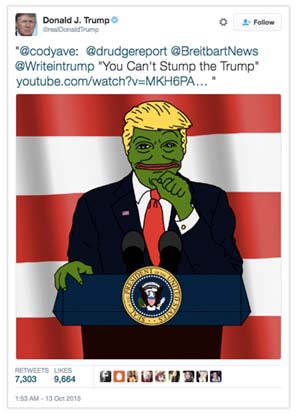When artist Matt Furie created a green frog named Pepe for a comic book Boys Club in 2005, he intended the character to be mellow version of himself. The gloomy-faced amphibian soon spread like wildfire over the internet, gaining overnight stardom as the quintessential "sad frog" meme. At first, Pepe led a life everyone could identify with. In the ruckus of the online world, he became the face of first world despair—sadness (when an oreo you dunked in milk breaks off and sinks to the bottom), loneliness (when you finally get a text, but it is just from the phone company saying you used up all your data), or perpetual disappointment (when you are buff, but you have an ugly face). With his skyrocketing popularity came the rare Pepe memes, ones that were—to borrow from teen lexicon—"dank" versions of the sad frog. In the creator's own words,"he was a blissfully stoned frog who he enjoyed a simple life of snacks, soda and pulling his pants all the way down to go pee."
Fast forward to August 2017. The cartoon frog had transformed, for the worse. The alt-right brigade in the United States had appropriated him, using the character's massive popularity as a springboard to mainstream ideas or thoughts that were once considered abhorrent. The once earthy flavour of the memes was replaced by vile racism, xenophobia, anti-semitism and Islamophobia. The entire issue snowballed in the 2016 US elections, when Pepe became so hated an extreme right mascot that Democratic presidential candidate Hillary Clinton herself came down hard on the cartoon frog. Donald Trump had retweeted an image of Pepe's face superimposed on his figure. Hillary wrote an explainer: Pepe is a cartoon frog who began his internet life as an innocent meme enjoyed by teenagers and pop stars alike.
 (File) Pepe memes
(File) Pepe memes
But in recent months, Pepe’s been almost entirely co-opted by the white supremacists who call themselves the “alt-right.” They’ve decided to take back Pepe by adding swastikas and other symbols of anti-semitism and white supremacy.
Trump has retweeted his white supremacist supporters with regularity, but the connection between the alt-right and his campaign continues to strengthen. Trump has been slow to disavow support from Ku Klux Klansmen and white supremacy groups, and he recently hired Breitbart.com’s Steve Bannon as his campaign CEO (and Bannon isn’t shy about the fact that his “news” organization is the “platform for the alt-right”).
Now white supremacists have given Pepe the cartoon frog some Trump hair—and the candidate’s own son says he is “honored to be grouped with” him.
Later, the anti defamation league ADL classified him as a general hate symbol:
Pepe the frog character did not originally have racist or anti-Semitic connotations. Internet users appropriated the character and turned him into a meme, placing the frog in a variety of circumstances and saying many different things. Many variations of the meme became rather esoteric, resulting in the phenomenon of so-called "rare Pepes."
The majority of uses of Pepe the frog have been, and continue to be, non-bigoted. However, it was inevitable that, as the meme proliferated in on-line venues such as 4chan, 8chan, and Reddit, which have many users who delight in creating racist memes and imagery, a subset of Pepe memes would come into existence that centered on racist, anti-Semitic or other bigoted themes.

In recent years, with the growth of the "alt right" segment of the white supremacist movement, a segment that draws some of its support from some of the above-mentioned Internet sites, the number of "alt right" Pepe memes has grown, a tendency exacerbated by the controversial and contentious 2016 presidential election. Though Pepe memes have many defenders, the use of racist and bigoted versions of Pepe memes seems to be increasing, not decreasing.
However, because so many Pepe the frog memes are not bigoted in nature, it is important to examine use of the meme only in context. The mere fact of posting a Pepe meme does not mean that someone is racist or white supremacist. However, if the meme itself is racist or anti-semitic in nature, or if it appears in a context containing bigoted or offensive language or symbols, then it may have been used for hateful purposes.
It seemed that Pepe was on his deathbed. The memes got more hateful with each passing day; slowly, he was being depicted as Hitler, Mussolini and other fascist elements. Horrified by the course of events, Furie symbolically killed off Pepe with a comic that showed him in an open casket. It seemed that the countless faceless trolls on the internet had won.
But then, the creator decided to fight back. He urged the public to flood the internet with peaceful or nice versions of the Pepe. He started a kickstarter campaign #SavePepe. "Pepe became a meme around 2010, then stuck around the internet long enough to become an institutionally recognised hate mascot. Needless to say it’s a nightmare so I killed him off. But now I’d like to bring him back, and I’d like to ask your help in funding a new zine celebrating a resurrected Pepe, one that shall shine a light in all this darkness and feel good again," he said.
And latest, in the final week of August, Furie moved legally against a Texas school administrator Eric Hauser. The latter's book Adventures of Pepe and Pede pits the frog against an alligator Alkah, who was suspiciously reminiscent of a Muslim. The author settled. The book distribution was stopped and all profits were donated to the Council of American Islamic Relations (CAIR).
From within the seemingly unending depths of cyber debauchery, Pepe has risen again. But the question is, how many others will follow suit? And how many of them can?




